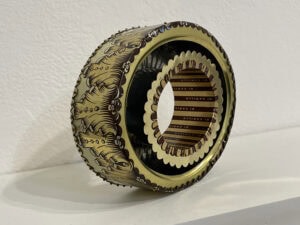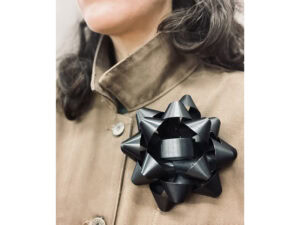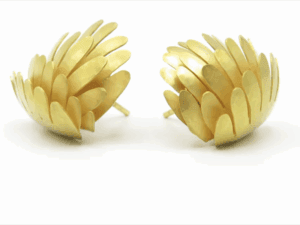20th July, 2014
Hey, Benjamin,
Great to hear from you. My examination was last Saturday and it was amazing. Presenting Māori knowledge back to the collective stakeholders of that specific knowledge is very nerve wracking more than giving an ordinary lecture. But the whānau (kin) audience related to the talk I gave and loved the exhibition. Phew! Then further speeches of acknowledgement followed spontaneously and waiata (songs of support)—it was very affirming. I felt the people had approved my degree and they backed it even though the Uni processes are still to be completed. It was the first time for Massey University that a PhD examination event had occurred on marae (on the ancestral homeland). I include an image to show the install at Koukourārata Marae—an uncarved meeting house (1924). Alan Preston, Pauline Bern, Jane Dodd and Caroline Billing were all there—and helped me pack down. We shared a meal and stayed Sat night at another marae (a modern carved meeting house), it was very special.

I am very happy for the tiki Hine-Āhua to be reproduced for AJF and an image is attached. You may be interested to note that the tiki form is named Hine-Āhua, but the toggle is also named. Huiarei is an ancestral name and a tribute to my Mum Hui-a-rei. Huia is an extinct bird/feather and Rei means to hang. In this piece I am interested in the naming of works as a personification.
I’ll get my act together this week and send some catalogues to you. And I have a few tiki for you to have a nosy at via The National.
Areta
13th Feb., 2015
Dear Areta,
I have just arrived in Auckland back from Wellington, to find a package from the National in my room: it contains your tiki.
I wanted to tell you how pleased I am to have it in my collection, and to thank you for being so patient.
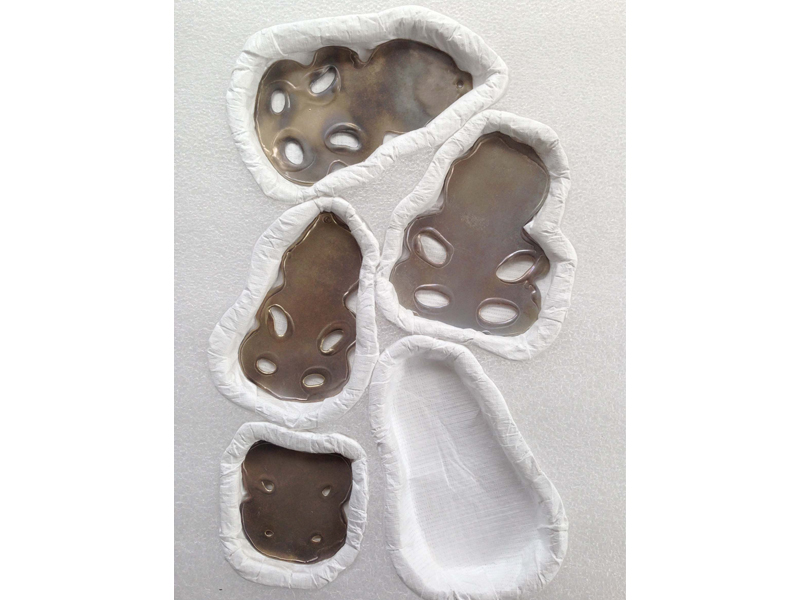
A few questions about the piece itself: do you intend for it to be worn? What care does it require? I had envisaged to hang it in my office, on the wall: please let me know if ‘hanging’ aligns with how you see this piece living in collectors’ homes.
Finally, the piece has no maker’s mark, which is fine by me. Do you provide a form of authentification to go with it? Should I ask Caroline?
I hope you are well,
Best from Auckland,
Benjamin
24th Feb., 2015
I am so, so sorry it’s taken ages to reply, I am pushed for time at the mo and not managing multi-tasking very well. I am less crazy until after the 10th March but I would love to talk with you.
I would love to talk with you about naming your tiki, this is appropriate and I wanted to suggest it anyway. Tiki is a personification, so a name is a Name, not a title. Therefore signing a tiki (as a personification) is weird for me, you would have noticed the tiki in the museum did not have signatures besides their makers “hand,” which is why I don’t sign tiki. However Caroline can make you a cert of authenticity. You may want to think about this process of authentication, what it represents and why it’s necessary for you, in terms of some writing one day.
![Hei tiki, 19th century, pounamu (greenstone), dimensions variable, courtesy Auckland Museum Tamaki Paenga Hira [AM5008] [AM53968] [AM30199] Hei tiki, 19th century, pounamu (greenstone), dimensions variable, courtesy Auckland Museum Tamaki Paenga Hira [AM5008] [AM53968] [AM30199]](/sites/default/files/art_blignel_areta_4_600x800px.jpg)
Does it need to be worn? Yes, sometimes. On the wall is fine but sometimes take her or him outside into the light and into life. I am enhancing my tiki’s provenance (whakapapa/genaology)—by wearing “her,” she was at my wedding, my graduation coming up etc. I call her by her name.
My tiki is called Hine-Āhua, the woman of the form/semblance.
Your tiki prob needs a name that links “here/Aotearoa” and “there/your life in France”? Something relevant. We should have it bi-lingual in Māori & French.
For example—and I am playing here—“Hine-of the-look-through-my-eyes”[1]—Māori & French can probably say this much more poetically.
Have a wee think about names, then let’s chat again.
Nga mihi,
Areta
25th Feb., 2015
Hello, Areta,
Thank you for your answer: no worries about being early or late, since the object in the focus of this email is moving in sync with things much larger and heavier than it is (the Māori, the visitors, the exchange between the two).
Regarding certification: I’ll ask Caroline. I am not bothered by having the piece signed or not signed—in part because I imagined that it existed differently from, say, a painting. However I was also interested to know how/if you, as the maker, wanted to claim authorship as well, and which protocols you would use to do that. There are three reasons for that: (1) there is a strong ritual aspect in the Māori proceedings that you, and other people, have described to me. Would this be applicable here? (2) I have just received a book titled The Contingent Object, which focuses on artworks that come with specific “procedures of existence”—often installational or fabrication guidelines—which dictate when and how they exist … and also how they can “fall out of existence” by not adhering to these procedures (3) you and I briefly discussed the tension between the contemporary and the customary. They have different relationships to the question of authorship, don’t they? How do you negotiate these?
Regarding naming: I love the idea of “Hine-look-through-my-eyes.” A nice way to refer to our meeting, but also to what I like/challenges me in being a visitor to your country (does “Hine” imply the female?) If you are happy with this title, can you try to find its equivalent in Māori?
Following reception of your email, I put a nail on the wall facing my desk (where I spend most of my hours), and hung the tiki on it (I actually wore it yesterday, and took it out to have lunch with me).
Take care of yourself,
Ben
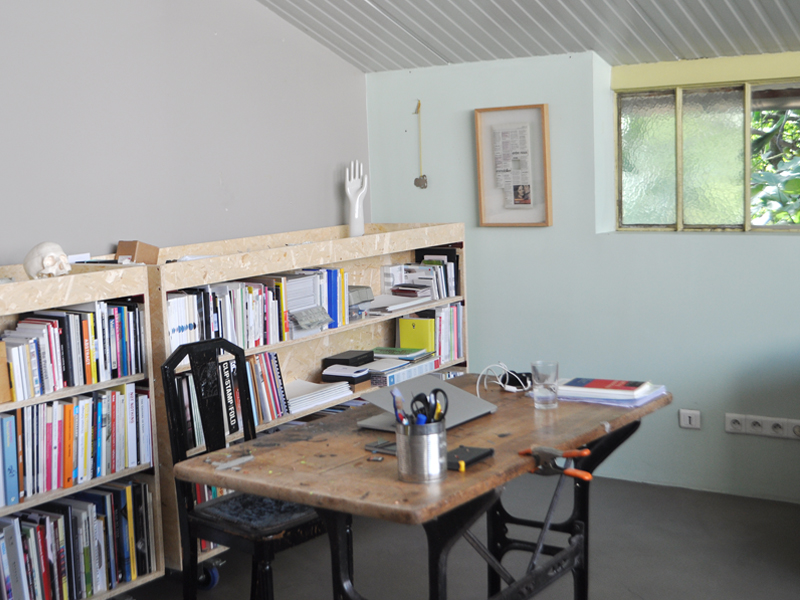
25th Feb., 2015
Love this stuff!
I would prefer not to sign the tiki (not so much as a laid-down protocol but it’s a maker’s “positioning” because I understand tiki as a personification, but this doesn’t mean I relinguish authorship, in fact I relinquish & claim at the same time. I made the work but she now has her own life now and the maker hopefully becomes less important—if she is to move into taonga (heirloom) status.
How do I negotiate this tension? With little difficulty—I recognise tiki has a whakapapa, a genealogy of its own. I don’t claim to create the first tiki, or rather “tiki” is not mine to claim—but I do claim this contemporary manifestation of tiki, if that makes sense. Similar to our discussion around aura and photographs (bearing in mind that photographs are a positive image), my photograms (which are not photographs) record shadows of objects so do not diminish the original objects, similarly neither does my manifestation of tiki. For Māori, keeping the whakapapa warm/alive/activated is crucial, otherwise it gets forgotten. Therefore my new manifestation of “old knowledge” (i.e. of older examples of cultural production) bring that older knowledge into this time. By doing so, the older knowledge is remembered and activated, therefore relevant, and therefore is enhanced by today’s “treasuring.” Referring to your “falling out of existence,” this does not happen if Māori & Māori artists invigorate (or recall) the whakapapa.
Re Hine (the woman) and her name.
“I like/challenges me in being a visitor to your country”—is exactly it—she offers another way of seeing/perceiving.
Hine-look-through-my eyes would ultimately mean seeing/perceiving the world through the eyes of tiki. What a concept that is! And that includes the world she perceives in France, and the way you are beginning to view the world in Aotearoa, and then the world from Aotearoa … Her name is an aspiration I guess to us all.
A name for Māori is not just linear, it is the here and now (like our meeting) but it’s deeper than that (the larger Aotearoa experience etc). There is always a deeper kōrero (narrative) behind it.
I’ll start talking to some language experts to get the name working well in Māori. How would you say her name in French?
🙂
Areta
12th March, 2015
Dear Areta,
I wanted to apologise for abruptly putting our exciting conversation on pause: I have had to prepare for Munich (where I am now) and this has gotten in the way of tiki conversations.
I am wearing your piece today, though, and will resume the discussion once I am back in Montreuil,
Take care,
b
30th March, 2015
Hello, Areta,
I take advantage of a minute of calm to jump back into the conversation.
I’ll simply recount my experience in the last few weeks as I wore your piece around my neck for most of my jewelry-related duties: one of the ways that “older knowledge” is being re-activated is when someone like me has to explain to, say, a German maker or a Dutch historian what it is that I am wearing. A necklace. A necklace with a tiki form. A necklace that is also a tiki. A necklace that references a customary Māori form, namely the tiki, an anthropomorphic creature that vaguely resembles a frog or toad, and used to be carved in green stone by Māori carvers. Is still being carved in green stone by Māori carvers. This green stone, by the way, is now only found on the north-facing side of the South island. This green stone is called Pounamou. Some people now use jade from China or Russian. Sheehan, Jo. A silver version of all this. A silver version of the tiki made by someone who is Māori and a contemporary jeweler. Made by a woman who lives in Oxford, New Zealand. Yes, a tiki. We are looking for a name for it, because tikis have names, and so should this one.
This is usually the farthest I go. I try to say this quickly, so that they get the greatest amount of information possible before the crackling tension of Munich (or the dinner where I am) gets the better of their attention span. Sometimes then we speak about the Māori, the settling of the Māori on the North Island, the warrior culture, the arrival of the whites. Often this leads to bi-culturalism, and my own dismay and fascination in front of it.
All this verbal explanation is both vastly simpler than what I have in my hand, and already an interpretation (mine). It is poorer, in a way, than the “old knowledge” (approximative, misinformed) and richer (already transformed into my own narrative: I put emphasis on those parts of the tiki-story that interest me, leave some out that are probably very important).
Am I rewriting it?
All these musing to ask you how you are doing, and inquire if perchance a Māori name has been produced.
I send you my best, and hope that the festival you were working on was a success,
Best,
b
30th March, 2015
I laughed out loud reading your email—thanks for sharing this.
…maybe the tiki is rewriting you?!
Areta 😉
26th June, 2015
Hell Areta,
Caroline has sent word to us that you will be showing at The National this August. Normally Susan would be conducting an interview with you, but I came up with a different plan: I asked Nigel if he would agree to do a “four-hand” interview with me, whereby we both field 5-6 questions to you.
I thought that his extensive knowledge of your work, as impeded by my visitor’s point of view, could possibly yield interesting results.
Can you tell me what you think of the idea, and if you are happy for us to proceed this way? If you are, I imagine that we could send you our questions the first week of July.
I thought it might be a good idea to share with him our email exchange about the naming of the tiki, as background information (also with a view to possibly reproducing this exchange in the final interview). Before I do so, I wanted to make sure that you were happy with this!
Ben
28th June, 2015
Absolutely! It was actually Nigel I wanted to share this with originally for help naming the work—it seemed the kind of thing to ask him face to face. Unfortunately, timing didn’t work out. This way we can discuss a Māori worldview, and our aspirations for tiki, and hopefully together name the work as an outcome, that would be cool.
By the way, Ben, do you think about the tiki (a human personification) as Tane (male) or Hine (female)?
I am back to Cambridge UK 16th July and could manage a Skype with you and Nigel. It would be great to also talk in real time.
Cheers,
Areta
29th June, 2015
Hello Areta,
Great, thanks for that. I will send Nigel my first volley of questions, as well as our email exchange. My questions so far largely exceed our search for a name: I am quite keen to provide our readers with a primer on your PhD work, and the many questions it raises. Hopefully we can do both the naming and the wider explanation …
I think when I first looked at tikis, I unconsciously associated them with monstrous/totemic beings (specifically Toltec and Olmec), probably male (because all things monstrous are male?). I think I also imagined that they were a double of the wearer—more literal than transformative—and so naturally, in my case, I projected “maleness” onto them.
Despite what I now know about tikis, I continue to view them (and it) as both apotropaic and totemic: i.e. as a talismanic thing that protects and empowers. This is a very pagan reading, with Christian undertones: any human (or human-looking) figure worn around the neck somehow exudes protection (like a patron saint, the Virgin Mary).
Skyping in July might be a tad difficult—I will be traveling with my family from the 12th onward. Let’s see how good a connection I get!
I hope your travels are inspiring,
Best
9th August, 2015
Nigel, I would also appreciate your help to gauge whether I have done an ok job trying to explain some cultural concepts. If something needs better clarification or you can see a way to simplify it better, please let me know. You also have the gift of te reo Māori language so I would also like your help with naming Benjamin’s tiki, if you may?
16th August, 2015

Hi Ben and Areta,
Here are my answers to the questions and the tiki name—please feel free to shape it/add to its explanation where needed—I’ve taken a little bit of creative licence in parts with the name, but I’m liking it and I think it fits really well: Kawei korero (explanation in the bottom of the word doc attached).
Let me know what you think, talk soon,
Nigel
Proposed hei tiki name: Kāwei kōrero
Kāwei are the tendrils of the hue (gourd plant); in Māori culture the rapid growth of the gourd plant and its kawei are metaphors to discuss our connections and relationships with others. Whether we be kin or colleagues, there are ties and connections that are made that change us. Kōrero is to speak, to communicate, to discuss, to be enlightened: to be changed through this process. Kāwei korero—the relational word, for me describes the kōrerorero (discussions) that we have all been engaged in for some time now. Like kāwei (tendril connections), the discussions are not one-way but rather go back and forth, shaping us all. The name is also a commentary about you, Ben, and the conversations that opened up when you made your visit to our shores last year and those conversations that have continued since. —Yes all very deep and philosophical…
N
16th August, 2015
Woo hoo Nigel—
Your added voice deepens the conversation. And I really love your input and expansion of the Hei Tiki’s name. Not only does it push the kuapapa and meaning out, but brings you into her whakapapa.
Fantastic.
You guys are awesome.
Areta
19th August, 2015
Hello Areta, hello Nigel,
I have been thinking about the French translation for Kāwei Kōrero. I looked for translations for the two words separately—tendrils are “vrilles” and Kōrero could be “parler, discuter, communiquer, être illuminé”—and came up with the ungainly “discuter en vrille” or if one is a bit Deleuzian, “discuter en rhizome” [to discuss rhizomatically]. The word “rhizome” describes both a type of root that shoots upward, and a philosophical concept for a system that allows multiple entry points.
It sort of works, but I think it is too intellectually “hip.”
A more useful and descriptive alternative—following the personified description Areta made of Hine-Āhua—would be to describe the concepts of Kāwei and Kōrero as the qualities of a being. And I came up with this:
“Celui qui fait pousser des conversations (en archipel)” or “He who grows (archipelagoed) conversations.” The “archipelago” reference comes from French poet René Char, who made much of the mental discussion he was having with poets dead and alive, and titled one of his poetry books Paroles en Archipel—each island in the archipelago possibly standing for a conversation, or person. I like that it squarely implies that the tiki can do things, and I like the references to growing links between islands. Do you think it works?
The frog on a canoe
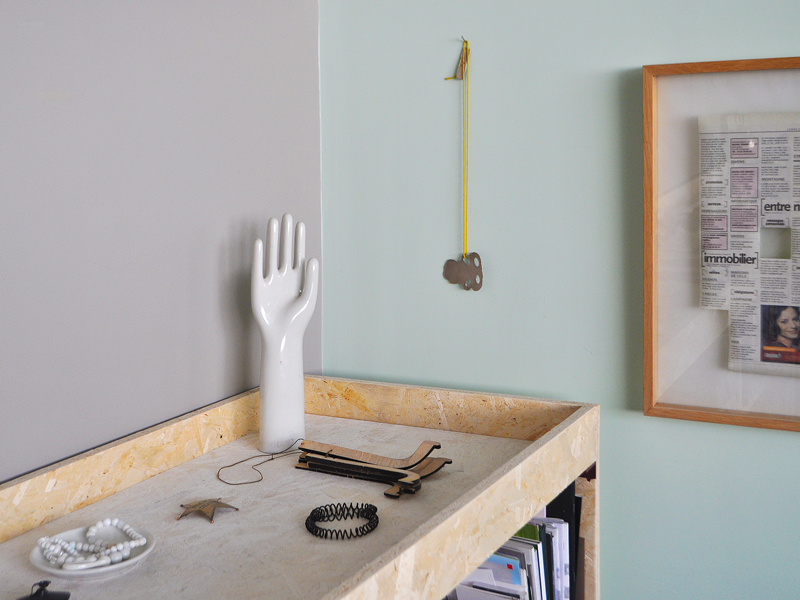
INDEX IMAGE: Areta Wilkinson, Tohu Aroha (detail), 2002, digital image, photo: Allan McDonald, design work by Kim Meek
[1] During our very first meeting, which took place in Areta’s Oxford studio in 2014, I expressed my dismay at the idea that certain māori cultural icons – like tikis – were basically ‘hands-off’: artists were not encouraged to reinterpret them, or tinker with them. To which Areta responded, at one point, with this line: “Insead of looking at this with your eyes, why don’t you look at this with my eyes”.

